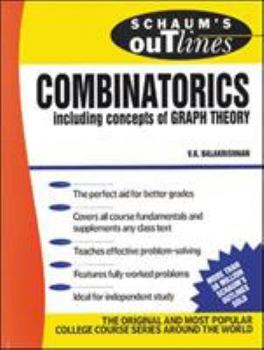Book Overview
Confusing Textbooks? Missed Lectures? Tough Test Questions? Fortunately for you, there's Schaum's Outlines. More than 40 million students have trusted Schaum's to help them succeed in the classroom and on exams. Schaum's is the key to faster learning and higher grades in every subject. Each Outline presents all the essential course information in an easy-to-follow, topic-by-topic format. You also get hundreds...
Format:Paperback
Language:English
ISBN:007003575X
ISBN13:9780070035751
Release Date:November 1994
Publisher:McGraw-Hill Companies
Length:208 Pages
Weight:0.80 lbs.
Dimensions:0.6" x 8.1" x 10.9"
Related Subjects
Calculus Discrete Mathematics Education Education & Reference Education & Training Electrical & Electronics Engineering Math Mathematical Analysis Mathematics Pure Mathematics Science & Math Study Study & Teaching Study Aids Study Guides Study Skills Studying & Workbooks Test Prep & Study Guides TextbooksCustomer Reviews
3 ratings
kind of good
Published by Thriftbooks.com User , 17 years ago
Not bad for those that have become accustomed to extensive math language within a text. The underlying concepts are explained well, however the density of material does take something away. Graph and group theory explanations should be more comprehensive. Considering the complexity of the various topics being presented this book is kind of good.
Nice job
Published by Thriftbooks.com User , 22 years ago
Combinatorics is an area of mathematics that is frequently looked on as one that is reserved for a small minority of mathematicians: die-hard individualists who shun the limelight and take on problems that most would find boring. In addition, it has been viewed as a part of mathematics that has not followed the trend toward axiomatization that has dominated mathematics in the last 150 years. It is however also a field that has taken on enormous importance in recent years do its applicability in network engineering, combinatorial optimization, coding theory, cryptography, integer programming, constraint satisfaction, and computational biology. In the study of toric varieties in algebraic geometry, combinatorics has had a tremendous influence. Indeed combinatorial constructions have helped give a wide variety of concrete examples of algebraic varieties in algebraic geometry, giving beginning students in this area much needed intuition and understanding. It is the the advent of the computer though that has had the greatest influence on combinatorics, and vice versa.The consideration of NP complete problems typically involves enumerative problems in graph theory, one example being the existance of a Hamiltonian cycle in a graph. The use of the computer as a tool for proof in combinatorics, such as the 4-color problem, is now legendary. In addition, several good software packages, such as GAP and Combinatorica, have recently appeared that are explicitly designed to do combinatorics. One fact that is most interesting to me about combinatorics is that it gave the first explicit example of a mathematical statement that is unprovable in Peano arithmetic. Before coming across this, I used to think the unprovable statements of Godel had no direct relevance for mathematics, but were only interesting from the standpoint of its foundations. This book is an introduction to combinatorics for the undergraduate mathematics student and for those working in applications of combinatorics. As with all the other guides in the Schaums series on mathematics, this one has a plethora of many interesting examples and serves its purpose well. Readers who need a more in-depth view can move on to more advanced works after reading this one. The author dedicates this book to the famous mathematician Paul Erdos, who is considered the father of modern combinatorics, and is considered one of most prolific of modern mathematicians, with over 1500 papers to his credit. The author defines combinatorics as the branch of mathematics that attempts to answer enumeration questions without considering all possible cases. The latter is possible by the use of two fundamental rules, namely the sum rule and the product rule. The practical implementation of these rules involves the determination of permutations and combinations, which are discussed in the first chapter, along with the famous pigeonhole principle. Most of this chapter can be read by someone with a background in a typical colle
excellent book !
Published by Thriftbooks.com User , 24 years ago
In its usual way schaum's series gives out another book which is both helpful yet concise. This book gives the essential grounding for combinatorics and graph theory without being overly gargantuan encyclopedia..ample problems set the tone for a future mathematician. they could've done better though..hence not the perfect 5 !






